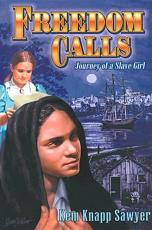From a Washington Post review about "race, teen woes, and hardship" by Mary Quattlebaum (May 12, 2001)
What is a hero? In a culture more concerned with spin than honesty, it's not always easy to tell. But there is one last bastion of heroics, one realm of determination where the flawed but good-hearted underdog can cling to personal integrity and eventually prevail. Young adult literature seeks out the quiet pulse of genuine heroism -- of courage in the face of adversity, endurance against overwhelming odds. . .
The Race for Freedom
In Freedom Calls: Journey of a Slave Girl (WM Kids, $17.95), author Kem Knapp Sawyer proves that courage knows no gender. Set in 1848 in Georgetown, the story follows 15-year-old Louisa as she leaps toward freedom on a whim.
As a servant on loan, the teen travels daily to her mistress's house, then back to the home of her owner, the Senator. On one homeward stroll, she overhears a clandestine conversation. " 'You may never get another chance like this one,' Louisa heard the man next to her whisper to his neighbor. She listened more closely and learned that he was trying to convince his friend to run away with him. He had heard that a boatman from New Jersey was willing to take fugitives north."
Days later, Louisa hides with 75 others in the crowded hull of a boat named the Pearl, until a mob chases down the boat and foils the bid for freedom. Because she is not shackled, Louisa flees during the hectic march to prison: She can go back to her home.
Abigail Bailey, the white, teenage daughter of abolitionist newspaperman Gamaliel Bailey, becomes Louisa's only hope. Harbored in secret, Louisa hides until Abby can help her secure a lasting freedom.
Louisa's quest is fictional, but many of Sawyer's details were drawn from historical documents. Seventy-six slaves did seek freedom on the waters of the Potomac; their captain was tried and convicted; the bodies of Gamaliel Bailey and his wife, Margaret, are buried in Georgetown.
